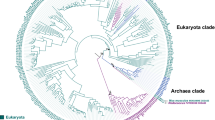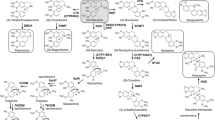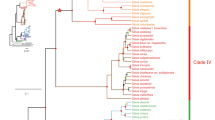Abstract
The plant alcohol dehydrogenases (ADHs) have been intensively studied in the last years in terms of phylogeny and they have been widely used as a molecular marker. However, almost no information about their three-dimensional structure is available. Several studies point to functional diversification of the ADH, with evidence of its importance, in different organisms, in the ethanol, norepinephrine, dopamine, serotonin, and bile acid metabolism. Computational results demonstrated that in plants these enzymes are submitted to a functional diversification process, which is reinforced by experimental studies indicating distinct enzymatic functions as well as recruitment of specific genes in different tissues. The main objective of this article is to establish a correlation between the functional diversification occurring in the plant alcohol dehydrogenase family and the three-dimensional structures predicted for 17 ADH belonging to Poaceae, Brassicaceae, Fabaceae, and Pinaceae botanical families. Volume, molecular weight and surface areas are not markedly different among them. Important electrostatic and pI differences were observed with the residues responsible for some of them identified, corroborating the function diversification hypothesis. These data furnish important background information for future specific structure-function and evolutionary investigations.





Similar content being viewed by others
References
Höög JO, Hedberg JJ, Stromberg P, Svesson S (2001) Mammalian alcohol dehydrogenase – functional and structural implications. J Biomed Sci 8:71–76
Boleda MD, Saubi N, Farrés J, Parés X (1993) Physiological substrates for rat alcohol dehydrogenase classes: aldehydes of lipid peroxidation, omega-hydroxyfatty acids, and retinoids. Arch Biochem Biophys 307:85–90
Martras S, Alvarez R, Martinez SE, Torres D, Gallego O, Duester G, Farrés J, de Lera AR, Parés X (2004) The specificity of alcohol dehydrogenase with cis-retinoids. Activity with 11-cis-retinol and localization in retina. Eur J Biochem 271:1660–1670
Garabagi F, Duns G, Strommer J (2005) Selective recruitment of Adh genes for distinct enzymatic functions in Petunia hybrid. Plant Mol Biol 58:283–294
Eklund H, Bränden CI (1979) Structural differences between apo- and holoenzyme of horse liver alcohol dehydrogenae. J Biol Chem 254:3458–3461
Danielsson O, Atrian S, Luque T, Hjelmqvist L, Gonzalez-Duarte R, Jörnvall H (1994) Fundamental molecular differences between alcohol dehydrogenase classes. Proc Natl Acad Sci USA 91:4980–4984
Persson B, Bergman T, Keung WM, Waldenström U, Holmquist B, Vallee BL, Jörnvall H (1994) Structural and functional divergence of class II alcohol dehydrogenase – cloning and characterisation of rabbit liver isoforms of the enzyme. Eur J Biochem 216:49–56
Chang C, Meyerowitz EM (1986) Molecular cloning and DNA sequence of the Arabidopsis thaliana alcohol dehydrogenase gene. Proc Natl Acad Sci USA 83:1408–1412
Gaut BS, Clegg MT (1993) Molecular evolution of the Adh1 locus in the genus Zea. Proc Natl Acad Sci USA 90:5095–5099
Perry DJ, Furnier GR (1996) Pinus banksiana has at least seven expressed alcohol dehydrogenase genes in two linked groups. Proc Natl Acad Sci USA 93:13020–13023
Morton BR, Gaut BS, Clegg MT (1996) Evolution of alcohol dehydrogenase genes in the palm and grass families. Proc Natl Acad Sci USA 93:11735–11739
Miyashita NT, Kawabe A, Innan H, Terauchi R (1998) Intra- and interspecific DNA variation and codon bias of the alcohol dehydrogenase (Adh) locus in Arabis and Arabidopsis species. Mol Biol Evol 15:1420–1429
Charleswort D, Liu FL, Zhang L (1998) The evolution of the alcohol dehydrogenase gene family by loss of introns in plants of the genus Leavenworthia (Brassicaceae). Mol Biol Evol 15:552–559
Gaut BS, Peek AS, Morton BR, Clegg MT (1999) Patterns of genetic diversification within the Adh gene family in the grasses (Poaceae). Mol Biol Evol 16:1086–1097
Koch MA, Haubold B, Mitchell-Olds T (2000) Comparative evolutionary analysis of chalcone synthase and alcohol dehydrogenase loci in Arabidospis, Arabis and related genera (Brassicaceae). Mol Biol Evol 17:1483–1498
Lin J-Z, Brown AHD, Clegg MT (2001) Heterogeneous geographic patterns of nucleotide sequence diversity between two alcohol dehydrogenase genes in wild barley (Hordeum vulgare subspecies spontaneum). Proc Natl Acad Sci USA 98:531–536
Dolferus R, Jacobs M, Peacock WJ, Dennis ES (1994) Differential interactions of promoter elements in stress responses of the Arabidopsis Adh gene. Plant Physiol 105:1075–1087
Martí-Renom MA, Stuart AC, Fiser A, Sánchez R, Melo F, Sali A (2000) Comparative protein structure modeling of genes and genomes. Annu Rev Biophys Biomol Struct 29:291–325
Bucher M, Brander KA, Sbicego S, Mandel T, Kuhlemeier C (1995) Aerobic fermentation in tobacco pollen. Plant Mol Biol 28:739–750
Zhang M, Maeda Y, Furihata Y, Nakamaru Y, Esashi Y (1994) A mechanism of seed deterioration in relation to the volatile compounds evolved by dry seeds themselves. Seed Sci Res 4:49–56
Zhang M, Yajima H, Umezawa Y, Nakagawa Y, Esashi Y (1995) GC-MS identification of volatile compounds evolved by dry seeds in relation to storage conditions. Seed Sci Technol 23:59–68
Zhang M, Nakamaru Y, Tsuda S, Nagashima T, Esashi Y (1995) Enzymatic conversion of volatile metabolites in dry seeds during storage. Plant Cell Physiol 36:157–164
Zhang M, Nagata S, Miyazawa K, Kikuchi H, Esashi Y (1997) A competitive enzyme-linked immunosorbent assay to quantify acetaldehyde-protein adducts that accumulate in dry seed during aging. Plant Physiol 113:397–402
Van Eldik GJ, Ruiter RK, Van Herpen MMA, Schrauwen JAM, Wullems GJ (1997) Induced ADH gene expression and enzyme activity in pollinated pistils of Solanum tuberosum. Sex Plant Reprod 10:107–109
Thompson CE, Salzano FM, Souza ON, Freitas LB (2007) Sequence and structural aspects of the functional diversification of plant alcohol dehydrogenases. Gene 396:108–115
Jeanmougin F, Thompson JD, Gouy M, Higgins DG, Gibson TJ (1998) Multiple sequence alignment with Clustal X. Trends Biochem Sci 23:403–405
Nicholas KB, Nicholas HB Jr (1997) GeneDoc: a tool for editing and annotating multiple sequence alignment. Distributed by the authors (www.psc.edu/biomed/genedoc)
Altschul SF, Gish W, Miller W, Myers EW, Lipman DJ (1990) Basic local alignment search tool. J Mol Biol 215:403–410
Altschul SF, Madden TL, Schaffer AA, Zhang JZ, Miller W, Lipman DJ (1997) Gapped BLAST and PSI-BLAST: a new generation of protein database search programs. Nucleic Acids Res 25:3389–3402
Rubach JK, Plapp BV (2003) Amino acid residues in the nicotinamide binding site contribute to catalysis by horse liver alcohol dehydrogenase. Biochemistry 42:2907–2915
Thompson JD, Higgins DG, Gibson TJ (1994) CLUSTALW: improving the sensitivity of progressive multiple sequence alignment through sequence weighting, position specific gap penalty and weight matrix choice. Nucleic Acids Res 22:4673–4680
Henikoff S, Henikoff JG (1992) Amino acid substitution matrices from protein blocks. Proc Natl Acad Sci USA 89:10915–10919
Sali A, Blundell TL (1993) Comparative protein modeling by satisfaction of spatial restraints. J Mol Biol 243:779–815
Laskowski RA, McArthur MW, Moss DS, Thornton JM (1993) PROCHECK: a program to check the stereochemical quality of protein structures. J Appl Crystallogr 26:283–291
Lüthy R, Bowie JU, Eisenberg D (1992) Assessment of protein models with three-dimensional profiles. Nature 356:83–85
Gattiker A, Gasteiger E, Bairoch A (2002) ScanProsite: a reference implementation of a PROSITE scanning tool. Appl Bioinformat 1:107–108
Richards FM (1974) The interpretation of protein structures: total volume, group volume distributions and packing density. J Mol Biol 82:1–14
Richards FM (1977) Areas, volumes, packing and protein structure. Annu Rev Biophys Bioeng 6:151–176
Voss NR (2006) The geometry of the ribosomal polypeptide exit tunnel. J Mol Biol 360:893–906
Gasteiger E, Hoogland C, Gattiker A, Duvaud S, Wilkins MR, Appel RD, Bairoch A (2005) Protein identification and analysis tools on the ExPASy Server. In: Walker JM (ed) The proteomics protocols handbook. Humana Press, Totowa, pp 571–607
Guex N, Peitsch MC (1997) SWISS-MODEL and Swiss-PdbViewer: an environment for comparative protein modeling. Electrophoresis 18:2714–2733
Gu X (2001) Mathematical modeling for functional divergence after gene duplication. J Comp Biol 3:221–234
Gu X, Vander Velden K (2002) DIVERGE: phylogeny-based analysis for functional-structural divergence of a protein family. Bioinformatics 18:500–501
Small RL, Wendel JF (2000) Copy number lability and evolutionary dynamics of the Adh gene family in diploid and tetraploid cotton (Gossypium). Genetics 155:1913–1926
Schwartz D, Laughner WJ (1969) A molecular basis for heterosis. Science 166:626–627
Freeling M, Bennet DC (1985) Maize Adh 1. Annu Rev Genet 19:297–323
Gemma S, Vichi S, Testai E (2006) Individual susceptibility and alcohol effects: biochemical and genetic aspects. Ann Ist Super Sanità 42:8–16
Lesk AM (1995) NAD-binding domains of dehydrogenases. Curr Opin Struct Biol 5:775–783
Baker PJ, Britton KL, Fisher M, Esclapez J, Pire C, Bonete MJ, Ferrer J, Rice DW (2008) Active site dynamics in the zinc-dependent medium chain alcohol dehydrogenase superfamily. PNAS 106:779–784
Valeyev NV, Downing AK, Sondek J, Deane C (2008) Electrostatic and functional analysis of the seven-bladed WD β-Propellers. Evol Bioinform 4:203–216
Jorrín JV, Maldonado AM, Castillejo MA (2007) Plant proteome analysis: a 2006 update. Proteomics 7:2947–2962
Acknowledgments
We would like to thank Dr. Ana Tereza R. Vasconcelos, Dr. Élgion L. S. Loreto, Dr. Laurent E. Dardenne, and Dr. Paulo M. Bisch for their helpful comments. This work was supported by the Institutos do Milênio and Programa de Apoio a Núcleos de Excelência, Conselho Nacional de Desenvolvimento Científico e Tecnológico, Fundação de Amparo à Pesquisa do Estado do Rio Grande do Sul, and Pró-Reitoria de Pesquisa da Universidade Federal do Rio Grande do Sul.
Author information
Authors and Affiliations
Corresponding author
Electronic supplementary material
Table 1S
(DOC 158 kb)
Table 2S
(DOC 114 kb)
Table 3S
(DOC 109 kb)
Table 4S
(DOC 103 kb)
Table 5S
(DOC 118 kb)
Fig. 1S
Multiple alignment of the protein sequences modeled and the template used in the modeling (DOC 47 kb)
Fig. 2S
Percent identity of the ADH sequences. The horizontal axis presents the data values being plotted. The vertical axis shows the fraction of data points with as small or smaller a data value (DOC 67 kb)
Fig. 3S
3D_1D averaged scores, as determined by the VERIFY_3D program for the models of the Brassicaceae botanical family (DOC 30 kb)
Fig. 4S
3D_1D averaged scores, as determined by the VERIFY_3D program for the models of the Poaceae botanical family (DOC 94 kb)
Fig. 5S
3D_1D averaged scores, as determined by the VERIFY_3D program for the models of the Fabaceae and Pinaceae botanical families (DOC 169 kb)
Rights and permissions
About this article
Cite this article
Thompson, C.E., Fernandes, C.L., Norberto de Souza, O. et al. Evaluation of the impact of functional diversification on Poaceae, Brassicaceae, Fabaceae, and Pinaceae alcohol dehydrogenase enzymes. J Mol Model 16, 919–928 (2010). https://doi.org/10.1007/s00894-009-0576-0
Received:
Accepted:
Published:
Issue Date:
DOI: https://doi.org/10.1007/s00894-009-0576-0




